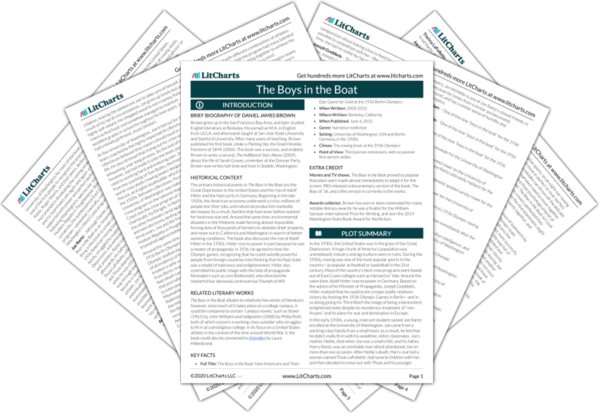The Boys in the Boat explores the vast cultural divide between the Eastern and Western United States in the early twentieth century. While the idea of an “East-West” rivalry is still a big part of American society, especially when it comes to sports, many of the differences between Eastern and Western America have disappeared in the last century. In the 1930s, communities on opposite sides of the U.S. didn’t necessarily have access to the same culture; they listened to different music, used different slang, ate different foods, and often respected subtly different values. This shouldn’t suggest that the East and West Coasts had nothing in common in the 1930s—nor should it suggest that Eastern and Western American cultures are identical in the twenty-first century. Nevertheless, in the era before the Internet, commercial aviation, or television, the East-West divide was undoubtedly starker than it is today. Furthermore, the East-West divide was especially apparent in the world of competitive rowing.
In part, there was a major East-West rowing rivalry during the 1930s because there really were major cultural differences between the Eastern and Western United States at the time. In the Eastern United States, WASP (i.e., white Anglo-Saxon protestant) culture dominated, and a huge portion of society’s elites hailed from traditionally WASP-y schools such as Harvard, Yale, and Princeton. These schools were also renowned for their rowing programs, the oldest (and usually regarded as the best) in the country. In this sense, East Coast crew teams represented the epitome of WASP-y, East Coast culture. By contrast, the Western United States in the 1930s was significantly more rural than the East, and lacked universities with the pedigree of a Harvard or a Yale. Recognizing the authentic differences between East and West, sports journalists wrote stories about crew competitions between West and East Coast that emphasized the “clash of cultures”—the refined Ivy League Easterners versus the rough, tough Westerners.
While there was some truth in the way sports journalists covered East-West crew competitions in the 1930s, journalists also exaggerated the contrast between different teams to make for a more entertaining story. For example, the often-repeated stereotype that Harvard and Yale’s crew programs were more “refined” than Cal’s or Washington’s was simply untrue: in the 1930s, Washington had the most precise, technically perfect rowers in the world. Similarly, sports journalists of the 1920s and 1930s often wrote stories suggesting that East Coast crew teams had stronger ties with Europe (where the sport originated). If anything, the West Coast had the stronger connection with European (particularly English) crew culture, since George Pocock, the finest boatmaker in the world and a masterful rower in his own right, served as an adviser for the University of Washington. Altogether, the East-West crew rivalry of the 1930s was partly a legitimate rivalry between two different American cultures and partly manufactured by sports journalists trying to sell more newspapers. (Daniel James Brown even suggests that, in some cases, the East-West rivalry was a self-fulfilling prophecy, in the sense that it encouraged crew programs to exaggerate their stereotypically East or West Coast qualities.) There are still plenty of East-West sports rivalries in 21st century America, but the East-West crew rivalry of the 1930s emphasizes the point that sports rivalries are a great way for different cultures to celebrate themselves, and that, almost a century ago, America was probably far more regionalized and culturally heterogeneous than it is today.
East Versus West ThemeTracker

East Versus West Quotes in The Boys in the Boat
The next year, 1924, Washington returned, with a young Al Ulbrickson rowing at stroke, and won the varsity race again, decisively this time. In 1926 they did it yet again, this time with Ulbrickson rowing the final quarter of a mile with a torn muscle in one arm. In 1928, Ky Ebright's California Bears won their first Poughkeepsie title en route to winning the Olympics that year and again in 1932. By 1934 the western schools were finally beginning to be taken seriously.
Ulbrickson knew full well that money more or less grew on the trees at Yale, and that funds had been vastly easier to come by in 1928, before the Depression, than in 1936.











